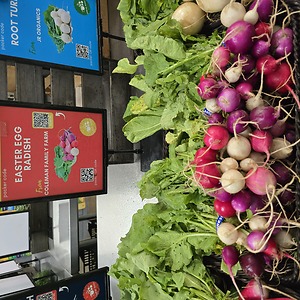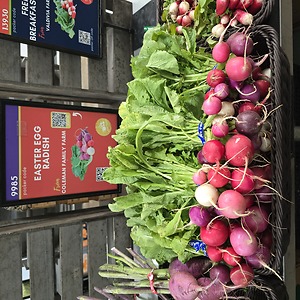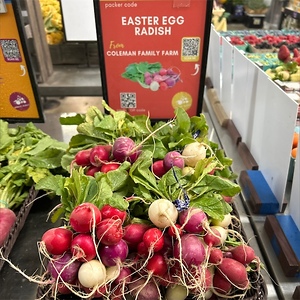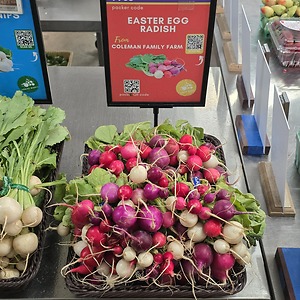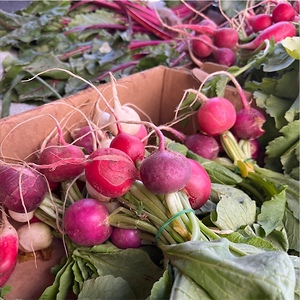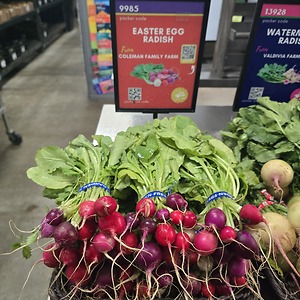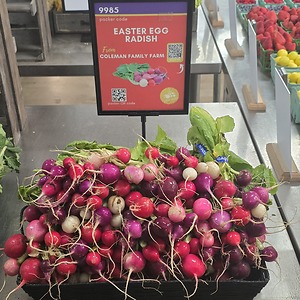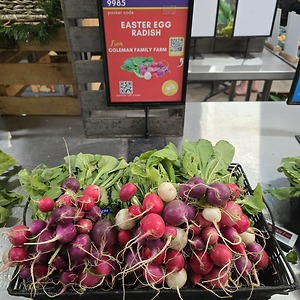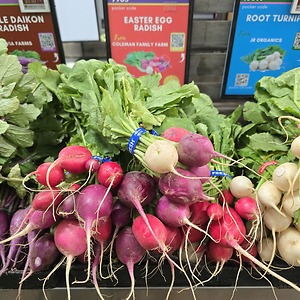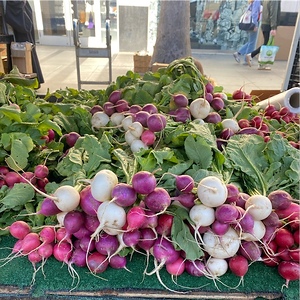

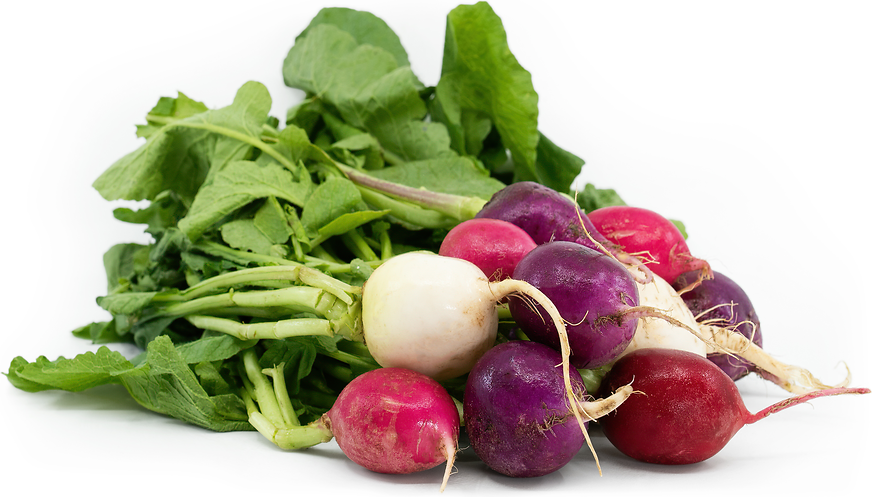
Easter Egg Radish
Estimated Inventory, 24 ct : 4.97
This item was last sold on : 07/19/25
Description/Taste
Easter Egg radishes are small in size, averaging 2 to 4 centimeters in diameter, and have a round to oval appearance tapering to a single taproot. The radish’s skin is semi-thin, smooth, and taut, showcasing various hues, depending on the variety, ranging in color from pink, purple, red, and white. Underneath the surface, the white, cream-colored, to ivory flesh is dense, firm, and exceptionally crisp. The flesh is also succulent, crunchy, and moist. Easter Egg radishes are known for their colorful nature and crisp, snap-like consistency and have a mild and peppery flavor with earthy and sweet undertones. The radishes also produce green leafy tops that are broad, flat, and serrated, attached to pale green, fibrous stems. The edible leaves can grow 15 to 20 centimeters in height and contribute a vegetal, green, and piquant taste.
Seasons/Availability
Easter Egg radishes are available in the spring.
Current Facts
Easter Egg radishes are a mix of several Raphanus sativus varieties belonging to the Brassicaceae family. It is important to note that the term Easter Egg is not a botanical name but a marketing descriptor for multiple cultivars of globe radishes to create a colorful blend. Easter Egg radishes are commonly made up of varieties such as Cherry Belle, Pink Beauty, White Beauty, and Purple Plum radishes. The radish mix is favored among growers for its fast-growing nature, ready for harvest approximately 25 to 30 days after planting, and the varieties are an early-season blend suitable for cool-season planting. Easter Egg radishes are popularly grown in the spring, marketed as a visually appealing bunch with a crisp, mild, and peppery flavor. Easter Egg radishes are versatile, consumed fresh, or utilized in cooked preparations.
Nutritional Value
Easter Egg radishes are a source of vitamin C to strengthen the immune system while reducing inflammation, potassium to balance fluid levels within the body, and calcium to protect bones and teeth. The roots also provide fiber to regulate the digestive tract, iron to develop the protein hemoglobin for oxygen transport through the bloodstream, and contain other nutrients, including vitamin E, magnesium, manganese, B vitamins, folate, vitamin K, copper, and zinc.
Applications
Easter Egg radishes generally have a mild, peppery flavor suited for fresh and cooked preparations. The roots should be washed and can be consumed straight out of hand, or they can be sliced and layered on salted butter bread. Easter Egg radishes can also be used as colorful, edible garnish, displayed on crudité platters, tossed into salads or shredded into slaws. Try chopping the radishes as a topping for tacos, layering them into sandwiches, or eating them as a healthy snack with dips and spreads. In addition to raw preparations, Easter Egg radishes can be roasted to bring out their natural sweetness, braised or stewed as a side dish, or sauteed with fresh herbs. The radishes can be used in any recipe calling for globe radishes and are also pickled for extended use. Beyond the roots, radish leaves are edible and can be sauteed, steamed, boiled, stir-fried, or sauteed. Easter Egg radishes pair well with aromatics such as chives, garlic, shallots, and onions, cheeses including goat, parmesan, and cheddar, and spring ingredients such as snow peas, corn, asparagus, and pea tendrils. Whole, unwashed Easter Egg radishes will keep up to one week when separated from the greens and stored in a sealed container in the refrigerator.
Ethnic/Cultural Info
Easter Egg radishes earned their name from their resemblance to the colorful painted eggs decorated in the spring around the Easter holiday. Historically, eggs represented fertility and new life in medieval Europe and were symbolic in early Christian and pagan traditions. Eggs were also considered an animal product, which was abstained from during Lent. Europeans would hard boil the eggs and store them until the end of Lent, becoming a celebratory meal after Easter. Eggs were also blessed and distributed the day before Easter at some churches, as the shell of the egg was symbolic of the tomb where Jesus was buried. On Easter, the shells were cracked to represent the resurrection of Jesus. Along with eggs, the history of decorating Easter eggs is somewhat muddled, as historians can trace the practice back to many cultures throughout Europe. Dying eggs have been a tradition for thousands of years, but it was also adopted during the Easter season to represent the story of the crucifixion and resurrection, using different colors for different meanings. Over time, decorating Easter eggs has become a secular practice to celebrate the spring season, and Easter Egg radishes have been paired with the holiday as they are grown around the same time. Easter Egg radishes resemble colorful eggs, and the radishes are sometimes grown in containers and baskets for Easter, as the top of the radish pokes through the soil, resembling a buried Easter egg.
Geography/History
Radishes are native to Asia and are believed by experts to have been growing wild in regions of China and Central Asia. The ancient roots are distinct from radishes in commercial markets in the modern-day and were cultivated in the early ages for the root’s strong flavoring and crisp nature. Much of the history of radishes is unknown, but the roots were spread along trade routes and through migrating peoples across Asia into the Middle East, Northern Africa, and Europe. Before the 16th century, most radish varieties were large, tough, and elongated. As demand for smaller radishes increased in Europe, breeders developed compact, circular radish varieties for everyday use, including globe-type radishes. Globe radishes became widespread throughout Europe by 1586 and were eventually introduced into the New World. Over time, several varieties of globe radishes were created in varying colors. In the late 20th century, seed packets were developed to have a mix of colored radishes, creating what is now known as Easter Egg radishes. Today Easter Egg radishes are commercially sold in grocers, local markets, and distributors and are also grown in home gardens worldwide.
Featured Restaurants
Restaurants currently purchasing this product as an ingredient for their menu.
| Kingfisher | San Diego CA | 619-861-8074 |
| Hotel Republic San Diego | San Diego CA | 951-756-9357 |
| Happy Medium SD | San Diego CA | 509-869-2279 |
| Secret Sister | San Diego CA | 619-281-0718 |
| Boujiemana | San Diego CA | 415-710-0510 |
| Culinary Kitchen Catering and Events | Coronado CA | 619-798-8477 |
| Lumi | San Diego CA | 619-955-5750 |
| Little Victory Wine Market | Carlsbad CA | 310-738-3380 |
| Bridges at Rancho Santa Fe | Rancho Santa Fe CA | 858-759-6063 |
| Sugar Bear Enterprises | San Diego CA | 925-383-3623 |
| The Bower | Coronado CA | 949-212-3192 |
| Ridgeview Health Center | San Diego CA | 858-293-3950 |
| Coast Catering | Escondido CA | 619-295-3173 |
| Georges at the Cove | San Diego CA | 858-454-4244 |
| Junkyard Sports Bar and Grill | Oceanside CA | 760-407-8500 |
| Jeune Et Jolie | Carlsbad CA | 858-231-0862 |
| Convention Center Shell | San Diego CA | 619-954-3063 |
| Park Hyatt Aviara (Ember & Rye) | Carlsbad CA | 760-448-1234 |
| Jake's Del Mar | Del Mar CA | 858-755-2002 |
| Pacific Terrace Hotel | San Diego CA | 858-581-3500 |
| Starlite Kitchen | San Diego CA | 619-358-9766 |
| Sandpiper Wood Fired Grill & Oysters | La Jolla CA | 858-228-5655 |
| Brockton Villa Restaurant | San Diego CA | 858-454-7393 |
| Saiko Sushi-Coronado | Coronado CA | 619-435-0868 |
| Rustic Root | San Diego CA | 619-232-1747 |
| Leu Leu | Leucadia CA | 619-316-5807 |
| Del Mar Country Club | Rancho Santa Fe CA | 858-759-5995 |
| Sago | Encinitas CA | 858-382-4047 |
Recipe Ideas
Recipes that include Easter Egg Radish. One
| The Real Food Dietitians |
|
Garlic Roasted Radishes |
| The Purple Carrot |
|
Spring Radish Fattoush |



